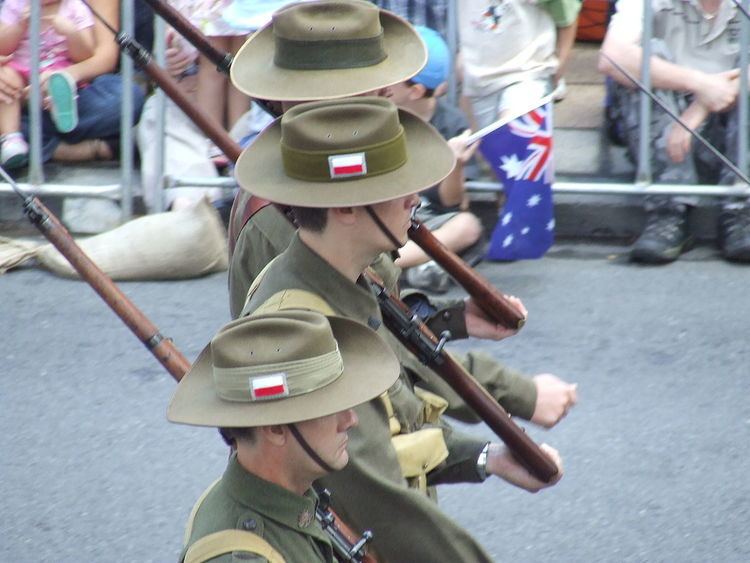 | ||
Unit Colour Patches (or simply known as Colour Patches) are currently worn on the slouch hat in the Australian Army to identify the wearer's unit. Unit colour patches are approximately 40 millimetres (1.6 in) x 40 millimetres (1.6 in) in size and have a large variety of colours and shapes to distinguish them.
Contents
First AIF
It is believed that the Australian system of colour patches is based upon the small patches of colours or tartan worn on the puggarees of their pith helmets by a number of British Army units during the South African War of 1899–1902. While some are recent creations many date back to World War I, when on 8 March 1915 1st Division Order No 81 was issued at Mena, Egypt authorising their creation by units of the First AIF. It was an extension of an order allowing the posting of distinctive colour flags to denote HQ and unit lines, and these flags were used as the basic design for 1st Division colour patches. These were worn on the sleeve, 1 inch (25 mm) below the shoulder seam.
Divisional Order 81 decreed a rectangular patch 1.25 inches (32 mm) by 2.75 inches (70 mm), and as further divisions created colour patches, the shape of the patch indicated the division:
Each Infantry Brigade within each Division was assigned a colour and the Brigade HQ colour patches were the Divisional shape in the Brigade colour. Each Battalion in each Brigade was then assigned a colour, and the patch was split horizontally with the Battalion colour across the top of the field and the Brigade across the bottom of the field. Light Horse, Artillery, Engineer and Medical units were also allocated colour patches. Light Horse patches were divided diagonally. In total over 300 individual patches were authorized during the war.
Citizen Military Forces
Military Order 206/21 in 1921 authorised the use of Unit Colour Patches for the Citizen Military Forces (CMF), which was raised in May, 1921. As this new organisation was based on the AIF, this order granted authority to the Citizen Military Forces to wear Regimental Colour Patches similar to those worn by corresponding units of the AIF. It also allowed for ex-members of the AIF serving in Citizen Military Forces to wear a miniature colour patch of the last AIF unit in which they served, worn above the CMF colour patch.
Second AIF
With the raising of the Second AIF in World War II, the unit colour patch was continued. A grey background of the same shape as the divisional patch was then included to denote a unit of the Second AIF, especially where that colourpatch had been used in the First AIF. Colour patches of World War I were generally larger than those of World War II, with the World War II square patch 38 millimetres (1.5 in) long on the sides, with an additional 5-millimetre (0.20 in) grey border if the colour patch had been used in the First AIF. New shapes were used, for example with the T-shaped patches instituted by the units of the 9th Division in 1943 representing their key role in the Siege of Tobruk. Over 800 separate patches were authorised during the war.
At right is the colour patch of the 2/17th Battalion. As a unit within 9th Division of the 2nd AIF, 17th Battalion has a T-shaped colour patch representing the Siege of Tobruk, with the grey background of the 2nd AIF.
Modern usage
The original series of colour patches was discontinued in 1949, and a new system was introduced in 1987 known as Series I and Series II colour patches. The Series I range are known as the 'Heritage' patches and are the pre-1949 patches maintained in a register with the Series I 'Extended' and Series II range introduced during the 1990s. Both are used in the Australian Army due to some units tracing their lineage to the First AIF units. The register also includes the patches for the Royal Australian Air Force and Royal Australian Navy patches.
